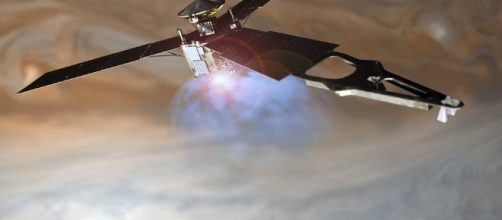NASA´s Juno mission completed its first of 36 orbits around Jupiter on August 27, 2016. Jupiter first close approach to the gas giant occurred at 6:44 a.m. PDT (9:44 a.m. EDT and 13:44 UTC); it was during these times that Juno flew through Jupiter’s top clouds at a distance of around 4,200 km (2,600 miles) and at a speed of about 208,000 km (130,000 miles)/hour. This was the first time that Juno Science instruments were activated, capturing the first ever close up images of the planet. 35 more flybys are planned to be performed by Jno during another 18 months of this mission which is schedule to end in February 2018.
First images taken by JunoCam
Juno was able to gather the first ever scientific data from Jupiter during this first mission’s close approach; however, scientists are still collecting and linking the data. It will take some days for the first science data to be disclosed; however, the first images form this close approach are expected to be released during the next couple of days. These pics include the first high resolution images of Jupiter´s cloudy atmosphere and the first ever look at the planet´s north and south poles. This marks the first time a spacecraft will send images of a part of the planet no other spacecraft has been before.
Juno mission
The spacecraft mission will study Jupiter’s atmosphere, measuring its composition and temperature.
It will take a deep look at the planet’s magnetic and gravitational fields, obtaining the real giant planet´s internal structure. It will explore the as giant´s magnetosphere at the poles and its auroras, understanding the planet´s huge magnetic field and the way in which this force affects Jupiter’s atmosphere. All of these scientific analyses will broaden our understanding of the beginnings and evolution of the biggest planet in the solar system.
New perspectives on the solar system´s formation
Juno spacecraft mission will help scientists understand the way in which giant planets form in their systems and the role they have in the formation of their entire system. Jupiter´s findings will allow astronomers to get a deeper insight, not only in the gas giant planet´s formation and evolution in the solar system, but on other systems in the universe. The innovative findings on Jupiter´s structure and formation will open new insights into the advancement of Astronomy and many areas of knowledge, including astrochemistry and astrophysics.

